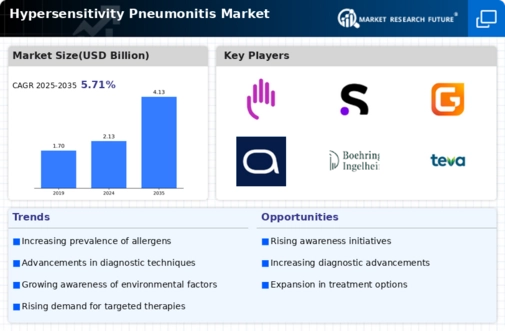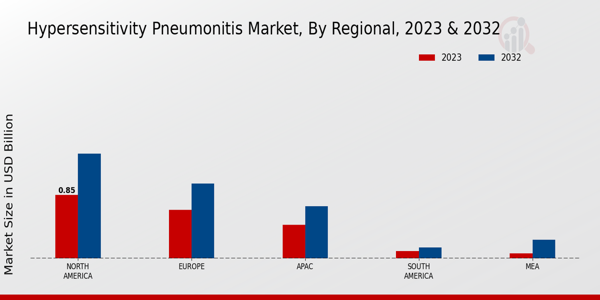Market Growth Projections
The Global Hypersensitivity Pneumonitis Market Industry is projected to experience substantial growth over the next decade. With an estimated market value of 2.13 USD Billion in 2024, the industry is anticipated to reach 4.13 USD Billion by 2035. This growth trajectory suggests a compound annual growth rate (CAGR) of 6.21% from 2025 to 2035, indicating a robust demand for effective treatment options and increased investment in research and development. The market dynamics reflect a growing recognition of hypersensitivity pneumonitis as a significant public health concern.
Growing Environmental Concerns
The increasing prevalence of environmental pollutants and allergens is a notable driver for the Global Hypersensitivity Pneumonitis Market Industry. Factors such as industrial emissions, agricultural practices, and climate change are contributing to a rise in respiratory diseases, including hypersensitivity pneumonitis. As more individuals are exposed to these environmental triggers, the incidence of the disease is likely to increase, prompting a greater need for effective treatment options. This trend underscores the importance of addressing environmental health issues, which could further propel market growth in the coming years.
Advancements in Diagnostic Techniques
Technological advancements in diagnostic methods are significantly influencing the Global Hypersensitivity Pneumonitis Market Industry. Enhanced imaging techniques, such as high-resolution computed tomography (HRCT), and the development of specific biomarkers are facilitating more accurate and timely diagnoses. These innovations are likely to improve patient outcomes and encourage healthcare providers to adopt more proactive approaches in managing the disease. Consequently, the market is expected to witness a compound annual growth rate (CAGR) of 6.21% from 2025 to 2035, driven by the increasing demand for precise diagnostic tools.
Rising Incidence of Respiratory Diseases
The global rise in respiratory diseases is a significant factor influencing the Global Hypersensitivity Pneumonitis Market Industry. As populations age and urbanization continues, the burden of respiratory conditions is expected to escalate. Hypersensitivity pneumonitis, as a form of interstitial lung disease, is likely to see increased incidence rates, particularly in regions with high exposure to organic dust and other allergens. This growing health concern is anticipated to drive demand for therapeutic interventions, contributing to the market's expansion and potentially reaching a valuation of 4.13 USD Billion by 2035.
Regulatory Support for Treatment Development
Regulatory bodies are increasingly supporting the development of new treatments for hypersensitivity pneumonitis, which is a key driver for the Global Hypersensitivity Pneumonitis Market Industry. Initiatives aimed at expediting the approval process for novel therapies are encouraging pharmaceutical companies to invest in research and development. This regulatory environment is likely to foster innovation and bring forth new treatment options that can improve patient outcomes. As a result, the market is expected to grow steadily, with a projected CAGR of 6.21% from 2025 to 2035.
Increasing Awareness of Hypersensitivity Pneumonitis
The rising awareness regarding hypersensitivity pneumonitis among healthcare professionals and patients is a crucial driver for the Global Hypersensitivity Pneumonitis Market Industry. Educational initiatives and campaigns by health organizations are enhancing understanding of the disease, its causes, and symptoms. This increased awareness is likely to lead to earlier diagnosis and treatment, thereby expanding the patient population. As a result, the market is projected to grow from 2.13 USD Billion in 2024 to 4.13 USD Billion by 2035, reflecting a growing recognition of the condition's impact on respiratory health.













